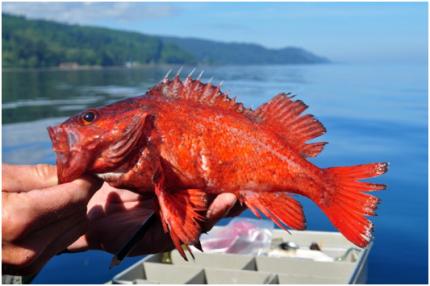
This identification guide is intended to provide information and key characteristics for common rockfish species in Washington’s marine waters. To access species information, click on a species name below. For each species, information is available on expected sizes, typical distribution, and published ages.
View and download a printable rockfish identification guide (PDF).
Please note that retention of certain rockfish species is prohibited May 1 through July 31. Review our downloadable sign (PDF) for more information.
More information on rockfish is also available in this April 2024 WDFW blog post.
Below are the definitions of characteristics helpful in identifying rockfish:
- Caudal fin: the tail fin.
- Dorsal: on the top side of the fish, or body element.
- Gill rakers: bony, toothlike projections from the front edge of the gill arch, opposite the gill filaments; often used as water filters to trap food items between the gill arches.
- Interorbital: between the eyes.
- Lateral line: a row of porelike openings on head and body; usually applied to the series of pores or pored scales along the side of the fish’s body.
- Pectoral fin: one of a pair of fins on each side of a fish that is attached to the shoulder girdle, behind the head.
- Ray: supporting bony elements of the fins.
- Spine: a bony projection, usually on the head. Also a single, hard, unbranched ray in a fin, i.e., a spinous ray.
- Suborbital: below the eyes.
- Symphyseal knob: a fleshy protuberance at the convergence of the bony elements of the lower jaw.
- Ventral: on the lower surface of the fish; on the belly.
For additional identification assistance, a dichotomous key for rockfish is available on the Oregon Department of Fish and Wildlife's Website.
The NOAA-Alaska Fisheries Science Center also provides identification information about rockfish common off the Alaskan Coast.
Rockfish species
- Aurora rockfish
- Black Rockfish
- Blackgill rockfish
- Blue rockfish
- Bocaccio Rockfish
- Brown Rockfish
- Canary Rockfish
- China Rockfish
- Copper rockfish
- Darkblotched rockfish
- Deacon rockfish
- Greenstriped Rockfish
- Rockfish hybrids
- Longspine thornyhead rockfish
- Pacific Ocean perch
- Puget Sound rockfish
- Quillback Rockfish
- Yelloweye Rockfish (Puget Sound/Georgia Basin DPS)
- Redbanded rockfish
- Redstripe Rockfish
- Rosethorn rockfish
- Rougheye rockfish
- Sharpchin rockfish
- Shortbelly rockfish
- Shortraker rockfish
- Shortspine thornyhead
- Silvergray rockfish
- Splitnose rockfish
- Tiger Rockfish
- Vermilion rockfish
- Widow Rockfish
- Yellowmouth rockfish
- Yellowtail Rockfish